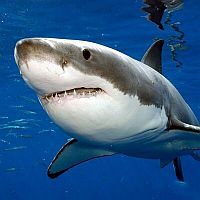
Katharine, Celebrity Great White Shark
In 1971, Blue Water, White Death, a documentary about great white sharks hit the big screens. I recall the documentary as thrilling and absolutely terrifying. White sharks were portrayed as monstrous killing machines, swimming in every ocean, ready to gobble us all up. And if that was not enough reason to stay out of the water, scenes from Blue Water, White Death were said to have inspired Peter Benchley’s best-selling 1974 thriller, Jaws. (Benchley also borrowed heavily from Melville’s Moby Dick, swapping out a white whale for a white shark.) Jaws the book was followed by Jaws the movie, followed by three sequels. The message was clear — sharks were viscous and terrible beasts. Be afraid! Be very afraid!
How times have changed. Sharks are being threatened by over-fishing all over the world. An estimated 100 million or more sharks are being caught every year. Scientists are warning that without sharks to keep oceanic food webs in balance, the entire ecosystem is at risk. Sharks need protection because they are important to so much life in the oceans.
Oddly, something else has been happening. Sharks have become a draw for tourism. Recently, the New York Times, riffed on a tag-line from the movie Jaws, “We’re going to need a bigger boat” with their article, “They’re Going to Need a Bigger Gift Shop.” The article describes how Chatham, on Massachusetts’ Cape Cod, now uses sharks to attract visitors.
After the nearly 40 years since “Jaws” first flashed its pearly whites on the silver screen, the mindless man-devouring machine at the center of the terror has been rebranded. Today it is less likely to be depicted as a ferocious predator than as a friendly dolphin-like character with a toothy grin.
Nowhere is the transformation more evident than here in this 350-year-old seaside town at the elbow of Cape Cod. With its spread of sandy beaches and inlets dotted with pleasure craft and fishing vessels, Chatham could have been the model for the fictional town of Amity in the movie, which was filmed on nearby Martha’s Vineyard. When sharks started cropping up here a few years ago, the town leaders at first feared they would flatline the robust tourist economy.
But instead of turning a blind eye like those in the movie, Chatham’s merchants and hoteliers embraced the sharks’ arrival.
Massachusetts is not the only place where the value of sharks as a tourist attraction has been appreciated. In 2010, the Indian Ocean island nation, the Maldives, made its territorial waters into a shark sanctuary. Maldives was the second nation to announce blanket protection for sharks, behind Palau, a tiny Micronesian state, which had announced a similar ban on shark fishing only a few months before. Why did theses tiny island nations decide to protect sharks? Both the Malidives and Palau are considered to among the world’s top scuba-diving destinations. In what some might think of as a reversal of roles, sharks attract divers.
As reported by the New York Times: In one sense, the bans represent pure economic logic. Researchers from James Cook University in Australia last year estimated that a single gray reef shark was worth $3,300 a year to the Maldivian tourism industry, compared with the one-time value of $32 that a fisherman would get from the same shark. They found a similar dynamic with regard to sharks on the Great Barrier Reef.
The internet and social media have also helped change views on sharks. OCEARCH, a non-profit research group, has been tagging great white sharks with satellite trackers which allows anyone with an internet connection to follow the individual great white sharks in real times as they travel up and down coast lines and cross oceans.
In what may have more to do with canny marketing than science, the tagged sharks are all given names, and, in some cases, Twitter accounts and blogs. Katherine, a 2,300 pound female great white shark, has become a minor internet star with 16,800 Twitter followers, her own Facebook page and blog. She is described on her Twitter account as “Misunderstood girl just tryin’ to get some fish.” Katherine’s celebrity has also attracted coverage by the Miami Herald, the Houston Chronicle, the New York Daily News and USA Today, among other print and online news outlets.
One of the hashtags used by OSEARCH is #replacefearwithfacts. Slowly the word is getting out. Sharks. as scary as they may be, are not that dangerous. You are far more likely to die from many other animals who do not appear anywhere near as threatening.
On average, slightly fewer than one person dies every year in the United States from a shark attack. Deer, by comparison, kill around 130 people every year, most related to collisions with cars. 50 people die each year from bee stings. Dogs kill over 30 people yearly and cows around 20. That’s right — you are twenty times more likely to die from an attack by a cow than a shark.
And as we know, the most dangerous creatures of all are humans. Thirty thousand of us die yearly in automobile accidents. So bottom line, you are at significantly great risk of being killed while driving to the beach than by being attacked by a shark once you get in the water.

Pingback: Scheepvaartnieuws | Bootjesgek.nl
One of these Great Whites they tagged, its been running up and down the east coast, possibly back into the Gulf, but I was unable to find the real-time tracker for it.